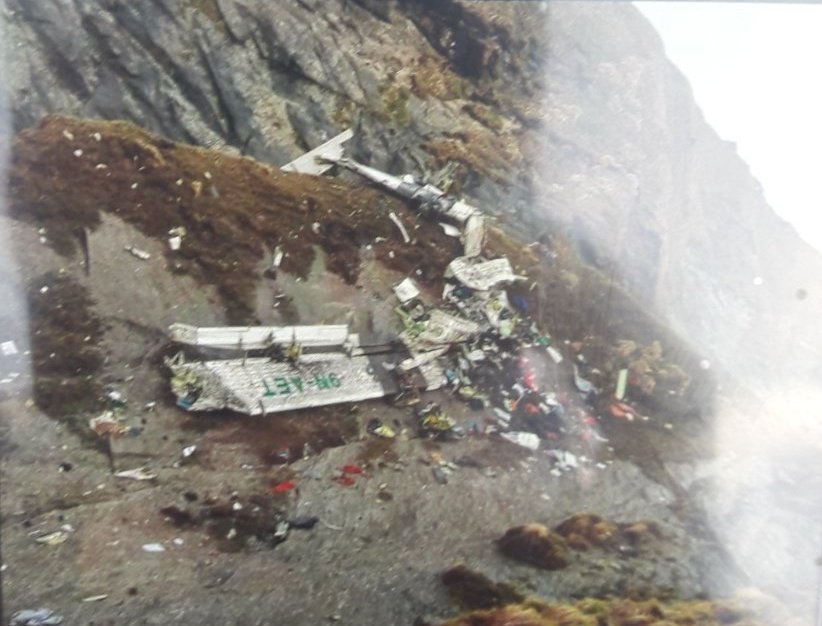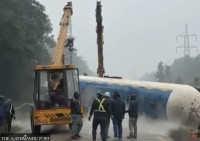National
Nepal missing passenger plane with 22 people aboard found crashed in a mountain
Wreckage of the Twin Otter that flew for Jomsom from Pokhara on Sunday morning was located near a mountain in Mustang on Monday morning.
Sangam Prasain
A Tara Air plane which had gone missing since Sunday morning was found crashed on a mountain on Monday morning. Bodies of 21 of the 22 people aboard the plane were recovered as of Monday night. One person is still unaccounted for, officials said.
This is the seventh crash in the Pokhara-Jomsom route in the last three decades.
The wreckage of the plane was found at Sano Sware Bhir in Thasang of Mustang, according to the Civil Aviation Authority of Nepal, the country’s aviation regulator.
Sixteen Nepalis, including three crew, four Indian and two German nationals were in the plane.
The registration mark 9N-AET Canadian-made DHC-6-300 Twin Otter plane had taken off from Pokhara to Jomsom at 9:55am. It lost contact with the air traffic controller at 10:07am in the Ghodepani area, according to a statement issued by the Civil Aviation Authority of Nepal.
The exact cause of the crash is unknown, officials said.
But the preliminary report shows weather factors behind the ill-fated crash.
“The plane was flying at 12,300ft and later slammed into a mountain at 14,500ft. This shows the plane made a fast climb to clear the terrain,” said an aviation expert, who wished not to be named because the government has formed a commission to probe the matter.
The nature of the crash and the position of the crashed aircraft shows the pilot wanted to avoid the cloud and during the course, the plane made a steep turn with an excessive bank angle.
A steep turn in aviation, performed by an aircraft, is a turn that involves a bank of more than 30 degrees.
“As per my observation, the flight captain may have seen clouds on his right. He then took a left turn, on the same side where he was seated, to avoid the clouds,” said a retired Twin Otter captain who has flown in the Pokhara-Jomsom route hundreds of times.
Aircrafts usually take a turn, left or right, for several reasons; one is to avoid obstacles like mountains or clouds.
“As soon as the aircraft made a banking turn to change the direction, in which the plane inclines, usually towards the ground or an obstacle which may be the hills, in this case, ground proximity warning system (GPWS) alarm may have rung,” the captain said.
The GPWS alerts pilots if their aircraft is in immediate danger of flying into the ground or an obstacle.
“Hence, in my observation, it looks like the flying captain made a steep climb in a bid to clear the terrain and slammed into the mountain,” said the captain. “The cockpit voice recorder will tell if this is the case or if there are any other causes behind the crash.”
The flight captain Prabhakar Ghimire, 62, seems to have tried to return to Pokhara, he said.
Tara Air Flight 197 from Pokhara to Jomsom was the first scheduled flight on Sunday at 6:15 am.
But it got delayed due to the poor weather condition. Before it took off at 9:55am, two planes of Summit Air departed for Jomsom, one of them just minutes ahead.
Then Captain Ghimire followed. He was in communication with the pilots of Summit Air about the weather condition.
“Before taking off from Pokhara, Captain Ghimire had reported that the Lete Pass on the Pokhara-Jomsom route is covered up [with clouds],” said Sudarshan Bartaula, chief security officer and spokesperson for Yeti Airlines, which also owns Tara Air that operates exclusively to the remote mountain fields.
Captain Ghimire waited until the weather improved, said Bartaula.
Utsav Pokharel was the co-pilot, who joined Tara Air a year ago, and Kismi Thapa was the flight attendant.
Ghimire was known as a zero risk-taker. An instructor pilot, he had vast experience in flying Twin Otters and he used to read books most of the time, according to his colleagues.
On Sunday morning, the plane was only 5 minutes away from landing at the Jomsom Airport at 2,736m.
This is the second deadly crash of Tara Air on the Pokhara-Jomsom route in seven years.
Pilots and air traffic controllers say there is risk in flying in Nepal’s remote sector but the Pokhara-Jomsom route is the most treacherous because of the changing weather patterns and several air pockets that frequently cause turbulence.
“The weather fluctuates within seconds on the Pokhara-Jomsom route,” said Tri Ratna Manandhar, former air traffic controller. “So, there is no rationale in saying why within three minutes one plane ahead of Tara Air landed and Tara Air couldn’t.”
The route is usually dangerous during the March-April period due to the wind factor and May-June due to pre-monsoon and monsoon factors, said Manandhar, the former director at the Civil Aviation Authority of Nepal.
“Preliminary reports show the weather factor behind the crash,” said Deo Chandra Lal Karna, spokesperson of the Civil Aviation Authority of Nepal.
“The exact details will be known after a detailed investigation.”
The plane was missing since Sunday morning.
A Nepal Army spokesman posted an image of the crashed Twin Otter plane on Twitter on Monday morning.

Sunday’s crash marks 104 air crashes in Nepal, except for the military, since the first reported crash of Kalinga Air, a private airline based in Calcutta, India, in Simara on August 30, 1955, according to the Civil Aviation Authority of Nepal’s aviation safety report 2021.
The crashes—of single-engine and multi-engine planes—have so far killed 862 people.
Sunday’s crash sheds light on Nepal’s poor aviation safety record although the Civil Aviation Authority of Nepal claims that Nepal’s performance has improved in the latest audit report by the International Civil Aviation Organisation (ICAO) last month.
The UN aviation watchdog ICAO has awarded Nepal an effective implementation score of 70.1 percent in its latest safety audit, ranking the country above the global average of 67.2 percent.
Nepali carriers have been banned from Europe over safety issues since December 2013, and a prerequisite to getting Nepal back in the good books is splitting the Civil Aviation Authority of Nepal into two entities—service provider and regulator. The government seems least bothered to stop the aviation regulator from performing dual roles.
Two long-pending aviation bills, whose passage would have hastened the removal of Nepal from the European Commission's air safety list, encountered setbacks after Tourism Minister Prem Ale stopped them from being tabled in the House for discussion in March.
“Holding up such crucial bills for years is a crime against public safety. It’s a wilful violation of legally established global regulations for handling issues of public safety,” Rajan Pokhrel, former director general of the Civil Aviation Authority of Nepal, told the Post in a recent interview.
In December 2013, the European Commission imposed a blanket ban on Nepali airlines from flying into the then 28-nation bloc after the September 2012 crash of Sita Air Flight 601 at the Manohara River near Kathmandu airport minutes after take-off. Nineteen people, including seven British citizens, died in the disaster.
The commission became more concerned after that fatal crash, and it prevented airlines from Nepal from entering the continent as the country reported a spate of air accidents over the years.
Between 2008 and 2012, Nepal saw at least two air crashes a year.
The European Union, since then, has been watching Nepal’s air safety development process closely.
Nepal’s aviation sector has been booming with air traveller numbers reaching nearly 10 million before the Covid pandemic with billions in investment in the industry.
The crash is a jolt to the burgeoning tourism industry.
According to Bartaula, Basanta Lama, another captain who was also travelling on the plane as a passenger, died in the crash. He had planned to visit Mustang after completing his flight on Sunday morning.
According to Nepal’s aviation safety report, before Sunday’s crash, in the last 10 years [from 2011 to 2020], the Jomsom airport witnessed the highest number of fatalities of 15 from 2 accidents, excluding the en-route accident, followed by Lukla, with 5 fatalities from two accidents.
“This makes the Pokhara-Jomsom route one of the most challenging routes. It is indeed difficult to navigate when the weather deteriorates suddenly,” said Sanjiv Gautam, former director-general at the Civil Aviation Authority of Nepal.
In Nepal, due to the difficult terrain, most of the crashes are Controlled Flight into Terrain (CFIT). This means an airworthy aircraft, under pilot control, unintentionally hitting the terrain.
Jomsom, which is about a 20 minutes flight from Pokhara, lies 200km northwest of Kathmandu. It is popular among both foreign tourists visiting the Mt Annapurna and Mustang region for trekking and Hindu and Buddhist pilgrims visiting the Muktinath temple.
But flying the route is challenging. The en-route terrain of the Pokhara-Jomsom sector is one of the most challenging in the world as planes have to fly through the Kali Gandaki gorge between the two 8000-metre mountains—Annapurna and Dhaulagiri.
In 2016 too, a vastly experienced Captain Roshan Manandhar died in Tara Air’s Viking 9N-AHH crash in Myagdi, flying from Pokhara to Jomsom, that killed 23 people.
Manandhar was the instructor of captain Ghimire.
Ghimire had more than 30 years of flying experience in remote areas.
Ghimire started his career with the Department of Civil Aviation, now the Civil Aviation Authority of Nepal, as an air traffic controller and later got a scholarship to pursue pilot training. After his training, he served the department as a pilot and was later the safety instructor of the civil aviation regulator. He moved to Yeti Airlines in 2004.
He held nearly 18,000 hours of experience flying Twin Otter under his belt.
His peers say he always followed flight safety protocols.
“In our country, where transportation is so difficult, getting people to remote areas and bringing sick passengers, people who are in dire need of help, these things give you satisfaction,” Captain Ghimire had said in an interview with NBC Left Field in April 2018.
But the Sunday flight was his last.
Search efforts were launched immediately after the plane went missing but they were hampered by bad weather.
Jomsom has a large share of crashes and casualties.
The first crash in Jomsom was reported on November 8, 1993, when a Nepal Airways Y-12 II plane with the registration number 9N-ACS crashed, but there were no casualties.
Four years later, on August 21, 1998, a Twin Otter leased by Nepal’s Civil Aviation body from Lumbini Airways crashed near Ghodepani after taking off from Jomsom, killing all 18 people on board.
On August 22, 2002, a Shangri-La Air’s Twin Otter crashed into a hill five kilometres southeast of Pokhara while returning from Jomsom, killing 18 people on board.
On May 14, 2012, a Dornier plane, belonging to then Agni Air, crashed at Jomsom Airport, killing 15. Six passengers survived.
After one year, on May 16, 2013, a Twin Otter of Nepal Airlines with 22 people on board touched down on the runway of Jomsom Airport and veered towards the right and fell 20 metres down the bank of the Gandaki River. There were no casualties.
The Jomsom route saw the worst disaster on February 24, 2016, when Tara Air’s Viking 9N-AHH crashed in Dana, Myagdi, killing 23 people.
It was Tara Air’s brand new Viking DHC6-400 Twin Otter aircraft brought in September 2015.




 8.12°C Kathmandu
8.12°C Kathmandu













%20(1).jpg&w=300&height=200)

